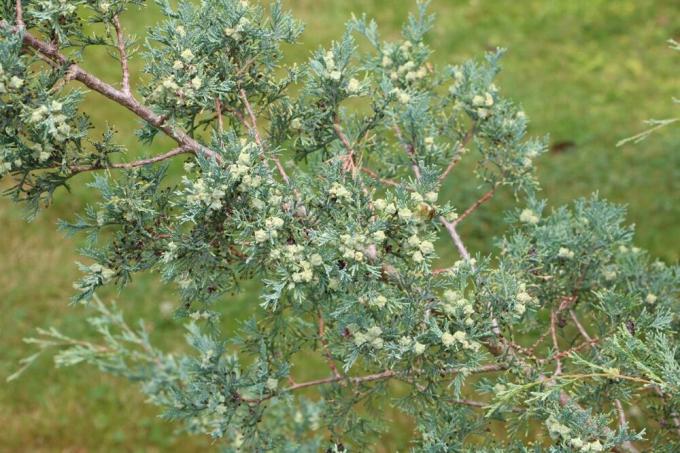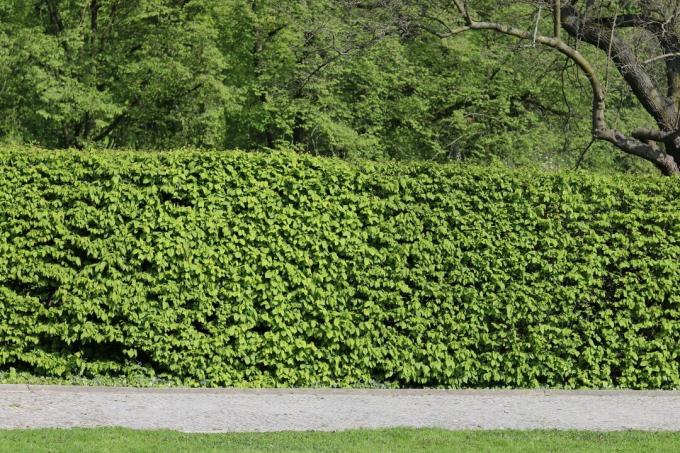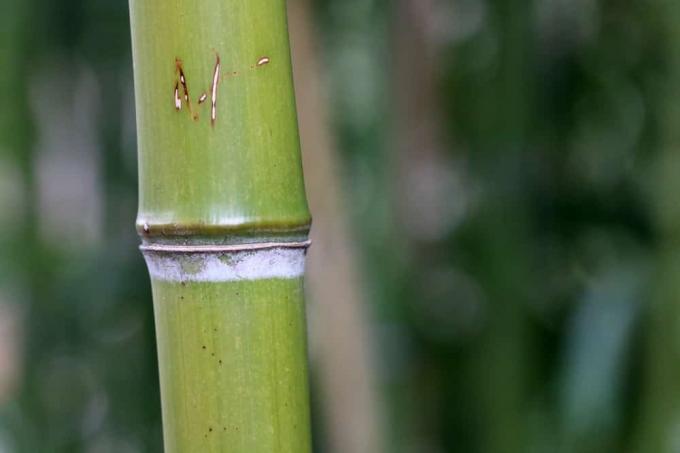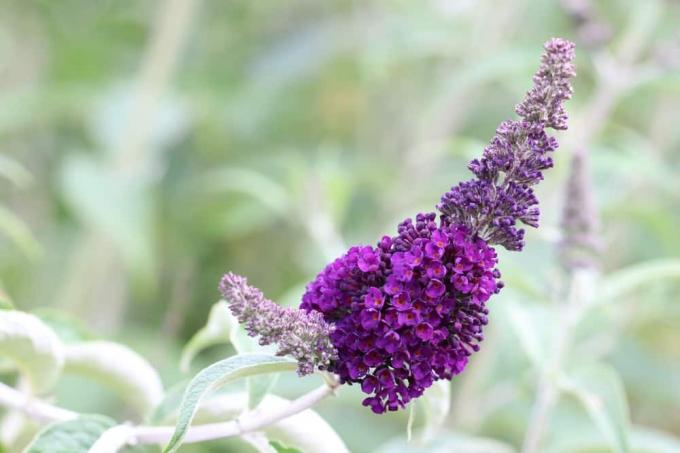

Table of contents
- Location
- substrate
- Pour
- multiply
- Fertilize
- Plant solitary plants
- creation of hedges
- Cut
- hibernate
- Conclusion
Scale-like leaves and small cones are hallmarks of cypress trees. A special beauty from this group of ornamental trees is Chamaecyparis lawsoniana Columnaris. With its striking foliage, which shimmers blue to blue-green depending on the viewing angle and light, the plant is by no means inconspicuous. The wood is considered to be robust, easy to care for and easy to cut. The blue cypress can also be cultivated temporarily in tubs. You should consider a few special features when caring for perennial plants.
Location
Chamaecyparis lawsoniana, the blue cypress, is one of the most beautiful representatives of its kind with its striking leaf colour. The evergreen tree can reach a maximum height of up to 6 m. Characteristic of the cypress family is their columnar, upright and compact growth. Its shape and slow growth make the Columnaris cypress interesting as a hedge plant. Planted correctly, the plant offers year-round protection from wind and the prying eyes of neighbors thanks to its evergreen foliage. The conifer species also comes into its own as a solitary plant. The shrub with the scaly leaves is hardy, there are a few factors to consider when choosing a location:
- Planted individually, Columnaris can grow up to 175 cm wide
- When creating hedges, the legal minimum distance to neighboring properties must be taken into account
- False cypresses are flat-rooted
- Not suitable for underplanting coniferous and deciduous trees
The plant does well in light partial shade. The dark green splendor of the leaves comes into its own here. Full sun locations are tolerated, but the substrate can dry out faster here. For this reason, you should water more often with young and freshly planted plants. Shady places in the garden are only partially suitable for the blue cypress. Lack of light is visually noticeable in growth, the plant becomes susceptible to diseases and pests. A few hours of sunshine a day should be available for the columnar cypress.
Tip:
In the first 3 to 4 years of life, the shallow-rooted plants can be cultivated in large tubs without much effort.
substrate

The consistency of the soil plays an important role and contributes significantly to the development of the plants. A large number of passionate hobby gardeners leave nothing to chance and use analyzes to determine the overall condition of the soil. The blue cypress is usually undemanding. A preparation of the substrate is still recommended for perennial plants. The following conditions have proven themselves:
- Nutritious
- permeable
- Profound
- Moist
- pH can be acidic to alkaline
Heavy soils, which have a high proportion of clay, for example, make it difficult to keep and care for many plants. The water seeps away slowly and the roots cannot exchange oxygen. It is not a sweaty job to prepare this soil for the columnar cypress. Mix the soil around the planting site with large amounts of sand. When mulching the soil, you should also occasionally incorporate this material. However, be careful not to create a substrate that is too dry. Because Chamaecyparis lawsoniana likes a humid environment. A balanced mixture of clay and sand is necessary so that the irrigation and rainwater does not evaporate too quickly. With false cypresses in the tub, you can fall back on conventional potting soil.
Pour
Evergreen plants have a decisive advantage over deciduous plants: Even in the cold season, they lose none of their dark green foliage. However, this advantage has a price that is noticeable in the care. The root ball of these plants must not dry out even in winter. Chamaecyparis lawsoniana is no exception. Most of the evergreen plants die in the cold season not from the cold but from drought.
- The blue cypress needs a basic moisture level in the soil
- In winter, it is watered on frost-free days
- A high lime content in the water does not harm the plants
- Avoid waterlogging
Drainage has proven itself for potted plants and in the ground. With this tool you ensure that the roots of the plants are not in the water. The columnar cypress likes it damp, waterlogging can cause considerable damage to the underground parts of the plant and make them susceptible to root rot.
- Work small pebbles or pebbles into the garden soil. Expanded clay pellets with a
- A layer of porous material is laid on the bottom of the planter
- Basalt, lava split and fine shards of pottery have proven themselves for this task
With solitary plants in the bed, you should work with a watering edge. This consists of soil that is arranged in a cone shape around the trunk and is slightly flattened. Keep this area weed free. Watering takes place in the morning and afternoon. This will prevent the water from evaporating too quickly at midday. Apply a thick layer of bark mulch around the columnar cypress. This will prevent the soil from drying out too quickly. The pieces of bark slowly rot and enrich the soil with important nutrients during this time.
multiply
Chamaecyparis lawsoniana 'Columnaris' and many other types of conifers are available all year round in nurseries and well-stocked garden centers. Existing plants can also be propagated by cuttings. The ideal time for this measure is between July and September. To increase the chances of success, you should take several cuttings.
- Choose slightly woody, strong shoots
- These are cut in a length between 8 - 12 cm
- Bevel the cut with a knife
- Branches and leaves are removed at the lower end of the shoot
- Put the cutting 2/3 deep in poor potting soil
- Keep the substrate evenly moist
Rooting can be done in a prepared bed in the garden. However, it is advisable to grow the cuttings on the warm windowsill. Avoid locations in full sun. Even in winter sunlight, the soil can dry out quickly, which can lead to the death of the young plants. Increase humidity with a makeshift greenhouse made from skewers and perforated foil. Temperatures between 18° - 22° C are ideal for the development of the roots.
After about 8 to 10 weeks, under optimal conditions, a fine network of roots should have formed in the vessel. Prick out the young Columnaris cypresses in good time before the subterranean parts of the plant grow together and separate with difficulty. If you want vigorous, healthy growth, you can use a trick. Cultivate the evergreen Columnaris exclusively in tubs for the first two years of life. Here you can directly influence the shape and growth. The false cypress should move into the garden with the first warm rays of sunshine in spring. Protection from direct sunlight is advisable for the first few days. The young plants are not used to the UV radiation, the foliage reacts with discoloration and burning.
Fertilize
The growth of the conifers from North America and Asia is moderate to medium strong. The plants are not very consuming plants, but they are dependent on a balanced supply of nutrients. In the garden it is sufficient if you work compost into the soil in spring and late summer. Horn shavings and brushwood have also proven themselves. Alternatively, you can opt for a long-term or Use liquid fertilizer from specialist shops.
- Use a special conifer fertilizer for hedges
- Fertilize between March and the end of August
- Do not exceed the stated dosage on the leaflet

The coloring of the false cypress is strikingly beautiful, but it also has a disadvantage: due to the The plant's bluish-green foliage finds it difficult to over- or under-dose with nutrients to recognize in time. Observe the plant closely and react as soon as the shoots hang limp or fast-growing "water shoots", transverse branches, form. In the event of over-fertilization, the supply of minerals should be stopped immediately. It takes a few months for the conifer to recover from this. If a nutrient deficiency has been determined, fertilizer is applied immediately. Do not exceed this dose to avoid further damage to the plant.
Between September and February you should neither apply compost nor liquid fertilizer. The evergreen plant is in the vegetation break. Too high levels of nutrients at this point can "burn" the roots and reduce the frost resistance of the cypress tree.
Plant solitary plants
Chamaecyparis lawsoniana belongs to the flat-rooted plants. With increasing age, the root network, which runs just below the ground, can reach an immense length. Only a few strands of skin penetrate into deeper layers of the earth. Take this into account when choosing the location. Especially power cables laid underground can be damaged by the plants. The evergreen ornamental can cope with root pressure from plant neighbors. With a width of up to 175 cm, the blue cypress is suitable for cultivation as a solitary plant. The plant picturesquely frames the entrance areas in the garden and separates individual areas so that they are opaque.
Purchased plants in pots should be given a sufficient bath in lukewarm water before moving them outdoors. Soak the roots until no more air bubbles form. In this way you create optimal starting conditions for the cypresses. Evergreen plants can be planted in the garden all year round. However, late summer or early autumn. There is enough time for the exotic beauties to acclimate to their new location and survive the winter unscathed. Proceed as follows when planting:
- Dig a hole twice the circumference of the cypress root ball
- The substrate is enriched with humus
- If required, mix in expanded clay, sand and/or loam
- Loosen the surrounding soil generously
- Insert the plant up to the upper root neck
- Fill in the prepared soil and press down firmly
- Slurp up properly
creation of hedges
Blue cypresses are impressive plants that offer a reasonable privacy screen thanks to their dense, evergreen foliage. When planting hedges, you should pay attention to a few special features. It is helpful to get a rough overview of the history first. sticks or Wooden slats and barrier tape will help you mark out the planned area. In this preparatory phase, a change is made quickly. Moving the planted conifers involves enormous effort.
Dig the garden area generously to a depth of 35 cm. Enrich the excavated soil with compost and fine pebbles. Regular mulching is difficult in the lower area of the hedge; the soil is permanently loosened with the stones. The minimum distance between the individual false cypresses depends on their size. Between 2 and 4 specimens per square meter have proved successful. For small plants, you can put several plants next to each other.
Cut
False cypresses tolerate pruning and, with patience and effort, can be "trained" into unusual shapes. If you are aiming for such a measure, you should start with young plants. The perennials do not tolerate a radical pruning back into the old wood. As soon as you remove the green area of the woody shoots, they can no longer sprout. Young side shoots cover the bare spots over time.
- The pruning and shaping takes place in the spring before the shoots sprout
- Hedges are also cut in late summer
- Disturbing and dead plant parts can be removed all year round
- Use gloves when working, the sap is poisonous
The Columnaris cypress has a major disadvantage: with increasing age, the plant bare from the inside out. Even regular pruning and proper care can only delay this decay, not stop it. It is not uncommon for many gardeners to completely eliminate hedges after 10 to 12 years due to the visual defect.
hibernate
The extraordinary ornamental tree is hardy, even double-digit minus temperatures and a thick layer of snow cannot damage the plants in the bed. Plants in buckets are an exception. With these there is a risk that frost will freeze the substrate in the container and the roots will suffer irreparable damage. In the fall, wrap the pot in burlap and keep the cypresses near walls. In the cold season you should occasionally check the substrate and water it if necessary.
Conclusion
Chamaecyparis lawsoniana Columnaris is an interesting plant that stands out due to its unusual leaf colouring. With its evergreen foliage, the tree also brings color to the winter garden. Only a little effort and time are required for the cultivation of the false cypresses. The idea of creating a hedge with the distinctive conifers should be carefully considered. The plants wilt over the years. In addition, the blue-green coloring of the leaves takes some getting used to and can quickly become annoying over a larger area.
 garden editorial
garden editorial I write about everything that interests me in my garden.
Learn more about hedges

Hornbeam hedge: 17 tips for care
Hornbeams (Carpinus betulus) are most commonly used as topiaries or hedge plants. They are actually not beeches at all, but belong to the birch family. The hornbeam is very robust, easy to care for and, in contrast to the common beech, not poisonous.

How fast does bamboo grow? | Information about growth
In domestic gardens, bamboo is usually used as a privacy screen or as a decorative solitary plant. The rapid growth, which can reach several cm a day, is impressive. It depends on the bamboo variety, care and the prevailing microclimate.

How fast does cherry laurel grow? | accelerate growth
The cherry laurel is a fast and densely growing tree. After planting, it usually only takes a few years for the young plants to grow into a tall, dense and evergreen hedge. In addition, growth can be accelerated by additional precautions.

Creating a mixed colorful hedge: 9 ideas for a mixed hedge
If you don't like it monotonous, you can also create a mixed hedge instead of a hedge from a single, evergreen plant species. There is a wide range of colorful hedges to choose from. There are special flowering hedges, ones for birds, scented ones, or for insects and butterflies.

Yellow cypress | 9 tips for care, pruning & growth
The yellow cypress is one of the most common hedge plants in our gardens. No wonder: it combines a great look with an opaque growth. How to properly care for them, cut them and generally promote their growth is here.

Thuja brabant turns brown or yellow: what to do? 8 common causes
When Thuja brabant turns yellow or brown, various factors can be responsible - but care mistakes are often the trigger. We reveal which factors are involved and how they can be counteracted.

